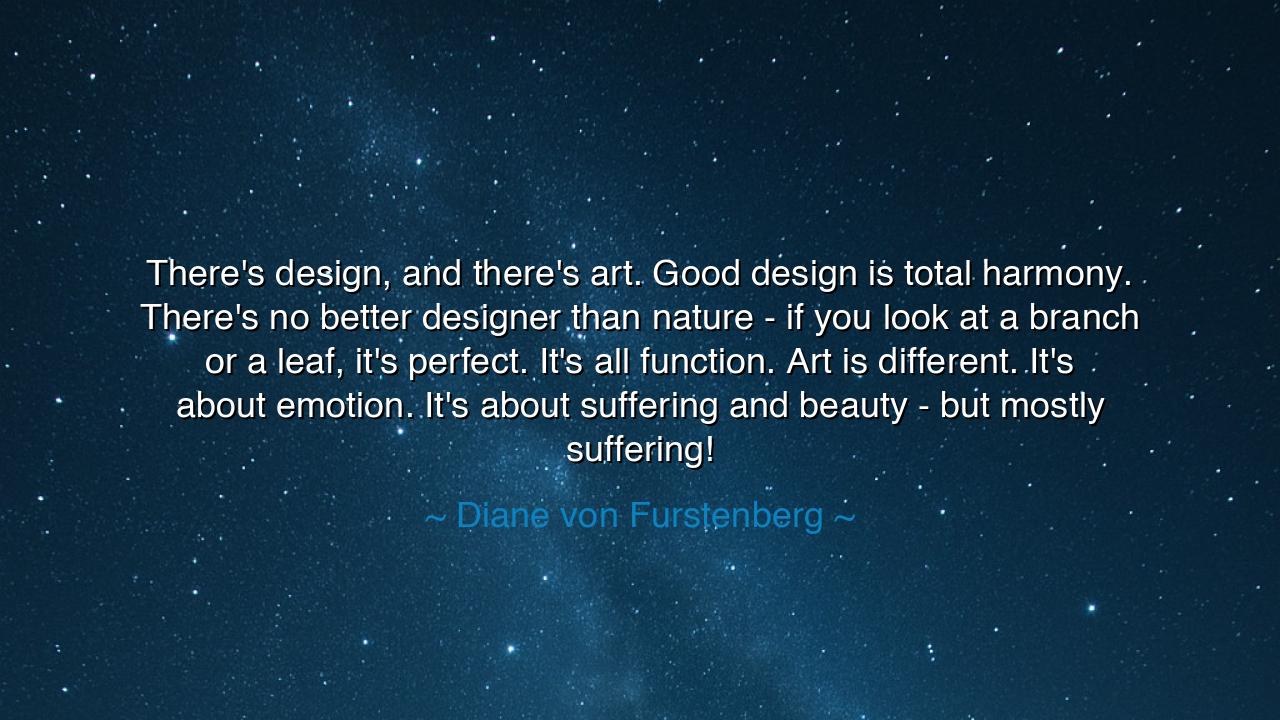
There's design, and there's art. Good design is total harmony.
There's design, and there's art. Good design is total harmony. There's no better designer than nature - if you look at a branch or a leaf, it's perfect. It's all function. Art is different. It's about emotion. It's about suffering and beauty - but mostly suffering!






“There’s design, and there’s art. Good design is total harmony. There’s no better designer than nature — if you look at a branch or a leaf, it’s perfect. It’s all function. Art is different. It’s about emotion. It’s about suffering and beauty — but mostly suffering!” – Diane von Furstenberg
In these luminous and soul-bearing words, Diane von Furstenberg, the great fashion designer and philosopher of style, reveals a truth that reaches beyond fabric and form — a truth about creation itself. She speaks to the eternal duality between design and art, between order and chaos, between harmony and heartbreak. Her words are both an ode to the divine perfection of nature, and a confession of the human heart’s restless search for meaning. For in her eyes, design belongs to the realm of balance, while art belongs to the realm of feeling. One reflects the calm intelligence of the universe; the other, the fierce and trembling soul of mankind.
The origin of this quote lies in von Furstenberg’s lifelong dialogue between structure and spirit. As a designer, she rose to prominence through clarity and purpose — her iconic wrap dress became a symbol of freedom and grace, perfectly uniting form and function. Yet beneath her practical mastery lay a poet’s heart, sensitive to the suffering and splendor of existence. Thus, she came to see that design seeks harmony, but art seeks truth — even when that truth wounds. Where design answers the question, “How can this work?”, art asks the deeper, more dangerous one: “Why must this hurt?”
To say that “good design is total harmony” is to recognize that design, at its highest, imitates nature. The branch, the shell, the snowflake — each is a masterpiece of purpose, shaped not by indulgence, but by necessity. A leaf does not strive for beauty; it is beauty because it serves its purpose perfectly. The bee’s wing, the spiral of a galaxy, the veins in a riverbed — all reveal a divine geometry, the unseen mind of creation itself. Von Furstenberg reminds us that the truest designer does not impose form upon life, but listens to the rhythm already written within it. This is why she calls nature the greatest designer, for its every detail sings of wisdom refined through eternity.
But then comes art, and with it, the storm. “Art is different,” she says — and indeed, it is born not of balance, but of emotion. It rises from the suffering and beauty of the human heart, that fragile mirror of the divine. Where design seeks to resolve, art seeks to reveal; where design aims for perfection, art dares imperfection. Consider Michelangelo, standing before the uncarved marble of David. His hands followed design — proportion, anatomy, geometry — but his soul followed art. He carved not merely a man, but a spirit caught between triumph and terror. The veins on David’s hands, the tension in his neck, the gaze fixed upon his unseen enemy — these were not function; they were emotion made eternal.
Von Furstenberg’s words remind us that design and art are not enemies, but twins of creation — one the body, the other the soul. Without design, art collapses into chaos; without art, design becomes lifeless. The harmony of design gives us shelter, comfort, tools, and beauty that sustains life. But the suffering of art gives us meaning, empathy, and beauty that transcends life. Humanity stands between them, always building and always feeling, always reaching for perfection yet always bleeding in the process. It is this paradox — this dance between structure and spirit — that makes us creators in the image of both God and nature.
History gives us countless examples of this eternal balance. Consider Leonardo da Vinci, who built machines that could fly and painted souls that could weep. His notebooks overflowed with studies of bones, muscles, and the flight of birds — the design of nature — yet within those same pages are sketches of faces filled with longing, laughter, and despair — the art of humanity. He did not choose between design and art; he united them, and in doing so, revealed that the perfection of the world and the imperfection of the heart are both sacred.
So, my child of creation and wonder, take this teaching into your own craft — whatever your craft may be. When you build, seek harmony. Let your designs follow truth, not trend. Learn from the leaf, the branch, the river, the wing — for nature never wastes, never lies. But when you create from your soul, allow the suffering. Do not flee from emotion, for it is through pain that beauty becomes eternal. Every masterpiece is a wound made holy — every song, a cry that learned to sing.
In the end, as Diane von Furstenberg teaches, design is the language of order, and art is the voice of the heart. Together, they form the architecture of existence — the calm and the storm, the leaf and the flame. To live fully is to move between them: to design one’s life with grace, and to paint it with courage. For though nature may be the greatest designer, it is the human spirit — trembling, flawed, and glorious — that dares to turn suffering into beauty, and thus completes the divine design.






AAdministratorAdministrator
Welcome, honored guests. Please leave a comment, we will respond soon